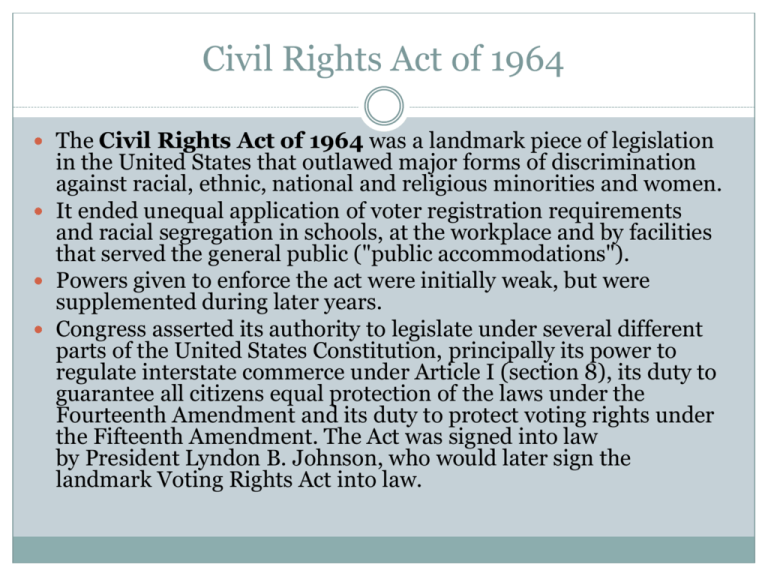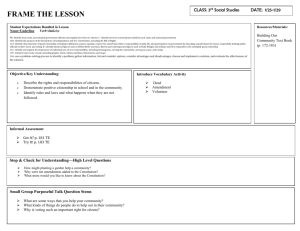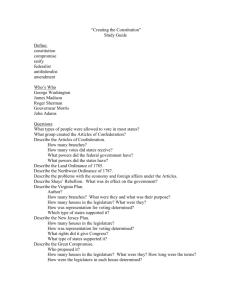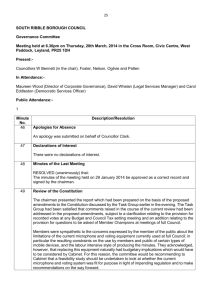Practice Problems - AP GoPo at Grandville High School
advertisement

Civil Rights Act of 1964 The Civil Rights Act of 1964 was a landmark piece of legislation in the United States that outlawed major forms of discrimination against racial, ethnic, national and religious minorities and women. It ended unequal application of voter registration requirements and racial segregation in schools, at the workplace and by facilities that served the general public ("public accommodations"). Powers given to enforce the act were initially weak, but were supplemented during later years. Congress asserted its authority to legislate under several different parts of the United States Constitution, principally its power to regulate interstate commerce under Article I (section 8), its duty to guarantee all citizens equal protection of the laws under the Fourteenth Amendment and its duty to protect voting rights under the Fifteenth Amendment. The Act was signed into law by President Lyndon B. Johnson, who would later sign the landmark Voting Rights Act into law. Voting Rights Act of 1965 The Voting Rights Act of 1965 is a landmark piece of national legislation in the United States that outlawed discriminatory voting practices that had been responsible for the widespread disenfranchisement of African Americans in the U.S. Echoing the language of the 15th Amendment, the Act prohibits states from imposing any "voting qualification or prerequisite to voting, or standard, practice, or procedure ... to deny or abridge the right of any citizen of the United States to vote on account of race or color." Specifically, Congress intended the Act to outlaw the practice of requiring otherwise qualified voters to pass literacy tests in order to register to vote, a principal means by which Southern states had prevented African Americans from exercising the franchise. The Act established extensive federal oversight of elections administration, providing that states with a history of discriminatory voting practices (socalled "covered jurisdictions") could not implement any change affecting voting without first obtaining the approval of the Department of Justice, a process known as preclearance. Practice Problem #1 Texas v. Johnson Facts of the Case In 1984, in front of the Dallas City Hall, Gregory Lee Johnson burned an American flag as a means of protest against Reagan administration policies. Johnson was tried and convicted under a Texas law outlawing flag desecration. He was sentenced to one year in jail and assessed a $2,000 fine. After the Texas Court of Criminal Appeals reversed the conviction, the case went to the Supreme Court. What portion(s) of the Constitution is relevant to the decision of this case? Why? Practice Problem #2 Gitlow v. New York (1922) Facts of the Case Gitlow, a socialist, was arrested for distributing copies of a "leftwing manifesto" that called for the establishment of socialism through strikes and class action of any form. Gitlow was convicted under a state criminal anarchy law, which punished advocating the overthrow of the government by force. At his trial, Gitlow argued that since there was no resulting action flowing from the manifesto's publication, the statute penalized utterences without propensity to incitement of concrete action. The New York courts had decided that anyone who advocated the doctrine of violent revolution violated the law. What portion(s) of the Constitution is relevant to the decision of this case? Why? Practice Problem #3 Heart of Atlanta Motel v. U.S. (1964) Facts of the Case Title II of the Civil Rights Act of 1964 forbade racial discrimination by places of public accommodation if their operations affected commerce. The Heart of Atlanta Motel in Atlanta, Georgia, refused to accept Black Americans and was charged with violating Title II. What portion(s) of the Constitution is relevant to the decision of this case? Why? Practice Problem #4 Lemon v. Kurtzman (1970) Facts of the Case This case was heard concurrently with two others, Earley v. DiCenso (1971) and Robinson v. DiCenso (1971). The cases involved controversies over laws in Pennsylvania and Rhode Island. In Pennsylvania, a statute provided financial support for teacher salaries, textbooks, and instructional materials for secular subjects to nonpublic schools. The Rhode Island statute provided direct supplemental salary payments to teachers in non-public elementary schools. Each statute made aid available to "church-related educational institutions.“ This case created the Lemon Test: To be constitutional, a statute must have "a secular legislative purpose," it must have principal effects which neither advance nor inhibit religion, and it must not foster "an excessive government entanglement with religion.“ What portion(s) of the Constitution is relevant to the decision of this case? Why? Practice Problem #5 Tinker v. Des Moines (1969) Facts of the Case John Tinker, 15 years old, his sister Mary Beth Tinker, 13 years old, and Christopher Echardt, 16 years old, decided along with their parents to protest the Vietnam War by wearing black armbands to their Des Moines schools during the Christmas holiday season. Upon learning of their intentions, and fearing that the armbands would provoke disturbances, the principals of the Des Moines school district resolved that all students wearing armbands be asked to remove them or face suspension. When the Tinker siblings and Christopher wore their armbands to school, they were asked to remove them. When they refused, they were suspended until after New Year's Day. What portion(s) of the Constitution is relevant to the decision of this case? Why? Practice Problem #6 Roe v. Wade (1972) Facts of the Case Roe, a Texas resident, sought to terminate her pregnancy by abortion. Texas law prohibited abortions except to save the pregnant woman's life. After granting certiorari, the Court heard arguments twice. The first time, Roe's attorney -- Sarah Weddington -- could not locate the constitutional hook of her argument for Justice Potter Stewart. Her opponent -- Jay Floyd -misfired from the start. Weddington sharpened her constitutional argument in the second round. Her new opponent -- Robert Flowers -- came under strong questioning from Justices Potter Stewart and Thurgood Marshall. What portion(s) of the Constitution is relevant to the decision of this case? Why? Practice Problem #7 Gideon v. Wainright (1964) Facts of the Case Gideon was charged in a Florida state court with a felony for breaking and entering. He lacked funds and was unable to hire a lawyer to prepare his defense. When he requested the court to appoint an attorney for him, the court refused, stating that it was only obligated to appoint counsel to indigent defendants in capital cases. Gideon defended himself in the trial; he was convicted by a jury and the court sentenced him to five years in a state prison. What portion(s) of the Constitution is relevant to the decision of this case? Why? Practice Problem #8 Gregg v. Georgia (1975) Facts of the Case A jury found Gregg guilty of armed robbery and murder and sentenced him to death. On appeal, the Georgia Supreme Court affirmed the death sentence except as to its imposition for the robbery conviction. Gregg challenged his remaining death sentence for murder, claiming that his capital sentence was a "cruel and unusual" punishment What portion(s) of the Constitution is relevant to the decision of this case? Why? Practice Problem #9 Arizona v. The Inter Tribal Council of Arizona (2012) Facts of the Case: The legal dispute over the registration requirement dates back to 2004 when Arizona voters passed a ballot initiative, Proposition 200, designed to stop illegal immigrants from voting. The measure amended state election laws to require voters to show proof of citizenship to register to vote, as well as identification to cast a ballot at the polls. Arizona residents, Indian tribes and civil rights groups sued to challenge measure. The registration law requires voters to present "satisfactory evidence" of U.S. citizenship, including a driver's license number, naturalization papers, U.S. birth certificate or passport. What portion(s) of the Constitution is relevant to the decision of this case? Why? Practice Problem #10 Why is the process of applying civil liberties to the states through the 14th Amendment referred to as “selective incorporation?” What does the game red rover have in common with selective incorporation? As a group, come up with your own metaphor of selective incorporation. Data Review Data Practice Gender Equality 19th Amendment : gender cannot be used to disqualify a voter Civil Rights Act of 1964 : banned gender discrimination in employment Griswold v. Connecticut (1965): privacy of sexual relations Roe v. Wade (1973): mother’s right to privacy Planned Parenthood v. Casey (1992): minors must wait 24 hours after gaining parent approval before getting an abortion. Also struck down “informed spousal consent” from Roe v. Wade.






